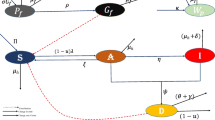Abstract
Waterborne gastroenteritis outbreaks have often gone undetected or been incompletely defined in terms of source and extent. Methods which allow detection or clarification of such events are therefore useful. We describe the methods used to detect and investigate such an outbreak. In autumn 1996 high school absence rates and the rate of parents absent from work to care for sick children suggested a health problem in a Swedish town which had a history of unexplained outbreaks of gastrointestinal disease. A systematic sample of 300 households was surveyed by post. Respondents represented 10% of the total population of the town. Questions concerning symptoms and exposures were included. The same questionnaire was used in a nearby town as a control. Sixty four percent of respondents reported an acute gastrointestinal illness during a two month period. Diarrhoea (90%) and abdominal pain (88%) were the most frequent symptoms among the sick. Two percent of those sick sought medical care. Exposures associated with disease were being a member of a large household, young age, and consumption of water from the community water supply. Attack rate showed a dose response relationship with increasing frequency of water consumption. The peak incidence of gastrointestinal illness occurred shortly after raw water quality control data had shown a rise in indicator bacteria. Further analysis, dividing those infected into groups according to when they became ill and whether they were the first member of their household to fall ill, supported the hypothesis of primary cases being infected from the water supply with some secondary person to person spread.
Similar content being viewed by others
References
Hartemann P, Newman R, Foliguet JM. Epidemiology of infectious discases transmitted by drinking water in developed countries. Rev Epidemiol Santé Publique 1986; 34(1): 59–68.
Birkhead G, Vogt RL. Epidemiologic surveillance for endemic Giardia lamblia infection in Vermont. The roles of waterborne and person-to-person transmission. Am J Epidemiol 1989; 129(4): 762–68.
Perz JF, Ennever FK, Le Blaneq SM. Cryptosporidium in tap water: Comparison of predicted risks with observed levels of disease. Am J Epidemiol 1998; 147(3): 289–301.
Goldstein ST, Juranek DD, Ravenholt O, Hightower AW, Martin DG, Mesnik JL, Griffiths SD, Bryant AJ, Reich RR, Herwaldt BL. Cryptosporidiosis: An outbreak associated with drinking water despite state-of-the-art water treatment. Ann Intern Med 1996; 124(5): 459–468.
Kramer MH, Herwaidt BL, Craun GF, Calderon RL, Juranek DD. Surveillance for Waterborne Disease Outbreaks — United States, 1993–1994. MMWR CDC Surveillance Summaries 1996; 45(1): 1–33.
Fogarty J, Thornton L, Hayes C, Laffoy M, O'Flannagan D, Devlin J, Corcoran R. Illness in a community associated with an episode of water contamination with sewage. Epidemiol Infect 1995; 114: 289–295.
Hedberg CW, Osterholm MT. Outbreaks of food-borne and waterborne viral gastroenteritis. Clin Mierobiol Rev 1993; 6(3): 199–210.
CDSC. Strength of association between human illness and water: Revised definitions for use in outbreak investigations. Commun Dis Report CDR Wkly 1996; 6(8): 65&68.
Harter L, Frost F, Vogt R, Little AA, Hopkins R, Gaspard B, Lippy EC. A three-state study of waterborne disease surveillance techniques. Am J Public Health 1985; 75(11): 1327–1328.
Wacholder S, Silverman DT, McLaughlin JK, Mandel JS. Seletion of Controls in Case-Control Studies, III. Design Options. Am J Epidemiol 1992; 135(9): 1042–1050.
Haas CN. Estimation of the risk due to low doses of microorganisms: A comparison of alternative methodologies. Am J Epidemiol 1983; 118(4): 573–582.
Snow J. Snow on cholera. Oxford University Press, 1936.
Lobel HO, Bisno AL, Goldfield M, Prier JE. A Waterborne outbreak of gastroenteritis with secondary person-to-person spread. Am J Epidemiol 1969; 89(4): 384–392.
Author information
Authors and Affiliations
Rights and permissions
About this article
Cite this article
McCarthy, N., de Jong, B., Ziese, T. et al. Epidemiological explanation of an outbreak of gastro-enteritis in Sweden in the absence of detailed microbiological information. Eur J Epidemiol 14, 711–718 (1998). https://doi.org/10.1023/A:1007490119187
Issue Date:
DOI: https://doi.org/10.1023/A:1007490119187




